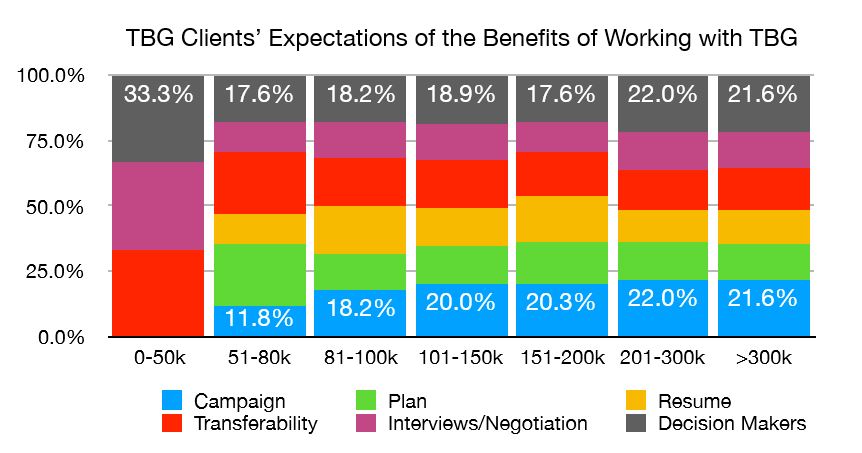Open Minds Win Big
Closed Minds Lose Out / Open Minds Win Big. As I’ve mentioned before, at the Barrett Group (TBG) we speak to tens of thousands of executives and managers each year. Many of them also fill out a survey and share their thoughts on where they are in their careers, their frustrations with their current situation, where they would like to be professionally in the future, and the primary support they would like from us.
As in most businesses, there is also a sequence of steps that prospects go through to become more and more acquainted with our services. At the second step in the process, we speak in detail about the issues addressed in their surveys and how we can prospectively help them. Some 50-60% of prospects at this stage earn between $100,000 and $200,000 per annum. About 45% of them are currently unemployed when they approach us and of these about 60% have been unemployed for 1-3 months while another 25% have been unemployed for more than 12 months.
Some are, of course, desperate to get back in the saddle and others are not.

About 50% of these prospects feel they are or were fairly compensated and more than 70% say they have specific career plans. Not surprisingly, the lower income group (<$100,000 per annum) feel worse about their current or former compensation (by about 15% points) than the better compensated group.
The emotional needs of the prospects are also quite clear in our client base that features a much higher share of dominant and extroverted individuals (High D and High I in DISC language) than the general population. Correspondingly, the prospects highlighted above fall into two groups that one might generally characterize as “victims” and “victors,” at least that seems to be the case based on the attitudes they project.
On the one hand, the victims cite statements highlighting their frustrations such as “my future earnings are limited,” “at my age a career change is necessary,” “I must get into a new industry,” and “I want a faster career track.”
The victors on the other hand are proactive and confident about managing their careers, citing statements such as “decreasing probability of promotions,” “employer management is changing,” “possible unemployment,” “job lacks challenge,” and “want independence.”
Naturally, the victims also stress the support they want from the Barrett Group very clearly, focusing in particular on “establishing a realistic career plan,” “showing how my expertise can be transferred,” and engendering “successful interviews and negotiations.” The victors generally project more confidence about their own abilities and are more focused on access to “decision makers” and ascertaining an “effective job search campaign.”
Whether you come from a place of frustration or a place of confidence, our Clarity Program© (the first step in our career change process) offers an ideal solution for clarifying your career objectives before you begin the career change process. In any case, it is critical that you approach your career change with an open mind. We have thirty years of experience in this industry. No single executive one could ever have that much experience in changing jobs.
So, simply put, the more open you are to the support we have to offer, the more you will benefit from it.
But don’t take our word for it. Here’s what one recent client had to say about our service:
The resources provided by TBG are invaluable – from resume drafting to business contacts/research, the tools cannot be underestimated. But, most importantly, the genuine service and support from my career coach, George Schulz, helped me land my new position. George’s unrelenting pushes and prods, coupled with motivational and encouraging words, were the biggest asset of the TBG program for me. Many thanks!
Kristina Brown, Senior Counsel at Brown, Moskowitz & Kallen
Peter Irish
CEO
The Barrett Group
Many Happy Returns – Return On Investment
Sometimes our clients are surprised at first to hear about paid search. They ask us, why should I pay for career management services, what is my return on investment?
Let me answer this with examples from my own life. All of the numbers are exactly true. The timing and the circumstances I will keep to myself if you don’t mind.

At one point in my life I was eager to move up and earn more but my employer felt they couldn’t afford it, so I hired a career management firm and paid them $4,500 (a lot of money for me back then). They taught me about myself using the Myers-Briggs Type Indicator, helped me write a resume and provided me with a mailing list. It took about two months until I had a job offer in my targeted industry at a substantial premium.
In that instance, I increased my compensation over the next three years by $150,000 cumulatively, a 33-fold return on my investment.
The next time, I was in Europe. I wanted to change countries and industries. I had no time due to the demands of my role. So, again, I hired a firm to help me research the unpublished market, write a strong resume and take me to market. In that case it took about three months until I had two solid offers in my target market. The return was also good. For $5,000, I added $200,000 in compensation over four years, a 40-fold return.
It gets more difficult sometimes as you get older, so the last time I hired a career management firm in Europe, I actually paid then €20,000. Their process was analogous to our process at the Barrett Group and included a thorough targeting exercise, psychographic analysis of behaviors to improve my self-knowledge, professional photos, handsome, snail-mail packages, and a hand-selected list of board chairmen (and women) in my targeted industries and geographies. We launched the campaign in September. I accepted a job in December.
Over the next three years, I received $600,000 in compensation, again, a 30-fold return.
Then there is the Barrett Group whom I hired in 2014 when I came back to the US. They helped me through a complicated set of career adventures until I realized that I actually did not want another corporate job, but would rather be in business for myself. Today we use the Clarity Program© (our “Targeting” process step) to help our clients clarify their targets up front partly because of my experience in 2014. Ultimately, I bought and built a business in California and the cash return (excluding equity) over five years is again 30-fold.
Are you seeing a trend here?
Yes, I may be unusual, but of the five times I used career management services, they were successful 80% of the time and returned 30-40 fold on my investment.
At the Barrett Group we offer a highly sophisticated, five-step process including our unique targeting step (the Clarity Program©), thirty years of professional experience in career management, hundreds of testimonials. Each full program client is supported by a six-member team, one of who is a negotiation coach. We help clients maximize the offers they receive by leveraging the experience of all of our historical clients to look under every stone and winkle out additional compensation elements before they accept a final offer. Typically this will add $10,000-$20,000 per client, easily offsetting our fees.
Think about the opportunity cost you are incurring by not employing a career management firm yourself. The career market has become more complicated and your time is valuable. Maybe it’s time you explored your options. We look forward to hearing from you so you, too, can enjoy many happy returns.
Peter Irish
CEO
The Barrett Group
Footprints in the Snow
We always try to address topics of broader interest to career changers in this blog. By and large, this means exploring “personas” that we run into repeatedly—whose issues we understand and whose career challenges we can help ameliorate. We’ve been doing this for three decades, so, of course, we have learned a thing or two about helping executives clarify their career objectives and then go out and get that perfect job. Footprints in the snow.
We are different from others in this space in several key ways. One is our Clarity Program© that constitutes the “Targeting” stage of our five-stage career change program. After all, our clients’ aspirations are far more complicated that just a title, salary, and geography. The Clarity Program© treats clients as the unique individuals they are.
Another key differentiator is that fully 75% of our clients land not via on-line job boards or recruiters but via the “unpublished market” where the competition is less and the remuneration is typically higher.

One key skill in navigating the unpublished market is the “information interview”—a telephone or face to face discussion with someone you have probably never met before who has been introduced by a mutual acquaintance. At various stages in my career I have had to conduct hundreds of these. Recently, during some career coaching sessions, I realized that the techniques I have evolved are extremely helpful to neophytes, so let me share a few of these here.
The first is what I call a branching script. As you approach a conversation with someone whose background you might know, but about whom you otherwise know very little, consider the subjects that might be of mutual interest and how you might introduce them in a gentle manner.
For example, when I was in the business coaching business not too long ago, I often found myself having networking discussions on the telephone with people who had no real idea why we were planning to talk. My branching script then began something like this: “There could be several topics of interest between us. For example, do you know business owners who are struggling and would benefit from a highly experienced and confidential advisor, or do you know individuals who might be thinking about transitioning in their careers and who might like to become business coaches, or who would I know that you might like to meet, or…” You may be surprised, but more often than not, my counterparts would say something like, “Actually, number 1 and number 3 sound relevant… Let’s explore.” For an information interview, that is a wide-open door. So consider preparing a branching script before you start an otherwise unplanned networking discussion.
Another technique that seems to work well is to visualize your discussion as a sort of radar diagram with radiating spokes representing different perspectives on the subject.
For example, let’s say you are planning to talk with the CEO of a larger business, not specifically about getting a job there, but more generally to understand what occupies that person and tangentially where you and he/she might have common interests—the classic information interview.
So in this case, one of the spokes on your radar graph might be what customers want from the CEO. Another might be what consumers want. Or employees. Or vendors. Or shareholders. Or the CEO him- or herself… In other words, by walking around the periphery of his or her business, you can get a very good understanding of how that person sees his or her world, where the challenges are and where there may be opportunities. Ultimately, this provides you with insights on how you might position yourself to address those challenges or take advantage of those opportunities were you to join that company or perhaps a competitor in the same industry.
My personal mental image of this process is from a bird’s eye view, looking down on my footprints in the snow as they slowly encircle the subject matter. It helps me make sure I have covered all of the perspectives I planned to cover, and lets me know when I’m finished. I hope you find these insights helpful and invite you to get in touch if you feel you could benefit from further career coaching… or just for an information interview.
Peter Irish
CEO
The Barrett Group
When Hiring Managers Go Silent… Getting Ghosted!
by Julie Norwell
You wrap up an engaging interview at a company and come away feeling that this position would be a great fit for you. You have the impression that the hiring manager feels the same way about you. He walks you to the door, you shake hands, say goodbye…and you never hear from him again. Ever. Not only does he not call, he doesn’t respond to your follow-up calls or emails. You’ve been ghosted!

If this has happened to you, you’re not alone.
Companies have been ghosting applicants for years, and it happens across many different industries. A recent survey by Recruiting Daily Advisor found that among applicants that have gotten ghosted, 23% were seeking jobs at business, finance and legal companies, and 22% were job seeking at advertising, marketing, PR and media companies. Many other industries also make the list, including healthcare, retail & hospitality, and tech.
Ghosting is a term that got its start in the world of dating when one person suddenly quits returning the phone calls, emails or texts of the other with no explanation because, you know, it’s too awkward to tell someone that you’re just not that into them anymore. Instead you just pretend that they don’t exist until they quit trying to contact you.
In the business world, the reasons behind getting ghosted are usually not so petty, but it’s equally painful – perhaps more so because, your ego notwithstanding, there are mouths to feed and bills to pay. How long should you hang in there waiting for signs of life?
Job Application Black Hole

Some people experience ghosting at the application stage. They send a resume to company after company with no response. There are several reasons for this:
First, maybe you’re not qualified for the job. According to Dan Resendes, Chief Consulting Officer at The Barrett Group, the biggest mistake job candidates make is submitting an application that doesn’t have 100% of the “must have” job qualifications. It demonstrates two strikes against you: 1) You aren’t qualified, and 2) you didn’t follow instructions. In this case, applying is a waste of time.
If you are 100% qualified and your application still gets no traction, your resume might be to blame. Your resume should reflect ALL the job qualifications, and not just in the body of the resume, but also in the headline.
Most hiring managers handle huge numbers of resumes and only read the top few lines of each one.
If you’re applying to a position requiring “international sales experience” and your resume headline reads “sales experience,” you won’t get a response – even if your international experience is highlighted later.
At the same time, you should omit all skills outside the scope of the job requirements. Many people include a laundry list of common core competencies in their resumes, but this sometimes works against you. Hiring managers might think you’re over-qualified, would become bored, or might ask for too much money. It’s counter-intuitive, but if the requirement is for 20 years of managerial experience and you have 25 years of experience, write only that you have 20 years of experience.
Lastly, if you’re applying as a stranger to a job posting, keep in mind that sometimes the job opportunities don’t actually exist. Companies often already have a #1 candidate in mind, perhaps through a referral or an internal promotion, but company policy requires that the job be posted publicly. If this seems unfair, don’t get mad; get a friend on the inside who can propel your candidacy.
How NOT to Get Ghosted
First and foremost is to avoid getting ghosted in the first place. How? By developing social ties and good communication.
Get on the Inside Track.
You should never apply as a total stranger to a company before exhausting all avenues to find a social connection. If you’re looking at $80K+ positions, you can be sure that the people who land these positions are not strangers to the company – they will have been recommended for the role. Find a friend to recommend you and you will have personal reputations and political clout to support you.
If that is easier said than done, don’t fret. Many successful professionals don’t know how to leverage networking to their advantage when they’re new to the job market. They’ve been on the giving, not the receiving, side of networking and may be out of practice with the slow, inconsistent process of building and expending social capital. But no one with 10-20 years of work experience, who has impacted people’s lives through hirings, promotions, and business deals, should have go into a job market cold. Always leverage your social capital first by asking your contacts how you might best proceed for a job.

Know Where You Stand.
When you’re in the screening process ask your counterpart (with a twinkle in your eye): “Do you think I’m a good fit for this opportunity?” Often, she will be honest and say, “Yes,” and tell you next steps. If the answer is “No,” it gives you the opportunity to offer more information about whatever reservations she might have.
As a general rule, the last item of discussion should always be a mutual agreement on next steps so you know the timeline for follow up communication. If they say, “We’ll get back to you by Monday,” and you don’t hear from them, wait one day and check in on Wednesday. If you haven’t nailed down a timeline, wait one week before reaching out to check in.
How to Handle Getting Ghosted at the Interview Stage
If you do get ghosted, there are several things you should keep in mind:
Be Patient and Courteous.
If you get no response to your check-in email, wait one week and call. If you get voice mail, leave your name, phone number and a short message saying, simply, that you’re checking in. Nothing more. DO NOT reference any other attempts to check in or offer reprobation about the lack of communication, lest it sound critical. Remember, this is the ONE person who can open a door for you. When all else fails, try to reach out to someone else at the company, preferably one with a social connection to you, who can advise you on how to proceed.
It’s (Usually) Not Personal.
Don’t take it personally. The most common reasons applicants are ghosted by companies is simply bureaucracy or inefficiencies in the hiring process. Candidate selection processes are often handled by lower-tiered people who are overwhelmed or inexperienced. Sometimes decision-makers aren’t available for interviews during the given timeline. Confidential corporate changes might be underway that hiring managers are prohibited from communicating to applicants. Or maybe the hiring manager just got hit by a bus. In other words, it’s them, not you.
Don’t Give Up.
Resendes tells a story of a client who came to The Barrett Group for career coaching six months after being ghosted by a company. Although he felt like he was a perfect fit during the interviews, he got no response to inquiries about his applicant status. He grew discouraged and gave up. His career coach convinced him he had little to lose in following up again, so he called the company and was greeted with a surprising exclamation: “Thank God you’ve called! We wanted to hire you but misplaced our hiring files and didn’t know how to reach you!” The client swore that the coaching fee was the best money he’d ever spent because he would not have called the company again on his own. The takeaway: If you are running short of options, you have no reason to stop following up.
Reverse Ghosting

If schadenfreude is your thing, you’ll be interested to learn that ghosting now cuts both ways. The incidence of job applicants blowing off scheduled interviews or even accepting jobs only to fail to show up for work without notice or further contact is on the rise. The trend has been reported not only by professional social network, LinkedIn and many news organizations, but also by the Fed.
Undoubtedly, the tight labor market makes it easier for job applicants to give companies a taste of their own medicine, but resist the temptation to do so.
Even if a better opportunity surfaces, it never pays to burn bridges. Keep to the moral high ground and hope that companies will learn their lesson about ghosting!
More articles by The Barrett Group:
Trends in Employee Benefits and Perks: How Important Are They to Your Overall Compensation Package?
by Julie Norwell
Employee benefits and perks have come a long way since the advent of company cars and casual Fridays. A review of emerging benefits and perks in today’s business world yields novelties. Such as “pet leave” for new pet owners, nap pods for sleeping breaks, and beer on tap. These kinds of offerings are certainly a testament to what appeals to millennial workers. They comprise an increasingly large share of the labor force. But it’s not just millennials who are driving this demand.

The volume and diversity of benefits and perks now available to workers at companies bespeaks the growing value that employees place on them in the workplace – a value that sometimes rivals hard cash. According to a 2015 survey by company review website, Glassdoor, nearly 80% of employees would prefer new or additional job benefits to a pay raise. They also play a significant role in the job search process. Three in five people report that benefits and perks are among their top considerations in accepting a new job.
In an employment market as tight as the current one, employers need to pay attention. Because those who don’t risk squandering an opportunity to attract the best talent.
FAMILY AND FLEXIBILITY
In 2015 Netflix made headlines by offering unlimited parental leave – to both moms and dads –in the first year after the birth or adoption of a baby. That offer was in addition to its unlimited time-off policy for vacation and sick leave.
Netflix is an outlier when it comes to such generous benefits, but many companies are, nevertheless, trending towards more family friendly and flexible leave offerings. According to the 2019 Employee Benefits Report of the Society of Human Resource Management (SHRM), which surveys employers annually about their employee benefits offerings, more than one in three U.S. employers offer paid maternity leave. Up from 21% in 2015, and many of them offer more leave than the federal and state mandates. In the same time frame, the number of companies offering paternity leave (30%) has almost doubled. Nursing moms will be happy to learn that this year more than half of U.S. employers report offering lactation rooms. This compares to just 35% in 2015.
Employers are ever more responsive to the high demand for flexibility in work schedules and remote working. With nearly 60% offering flextime during core business hours and almost 70% offering occasional telecommuting, up from 56% in 2015. In fact, more than one-quarter of respondents allow their employees to telecommute full-time.
FASTEST GROWING BENEFITS AND PERKS
The greatest increase in benefits were concentrated in health-related and wellness categories. 20% of employers indicating they had increased offerings in those areas. Given the prominent role many employers play in providing health insurance to employees, they have a great incentive in keeping healthcare costs down. And increasingly ply their workforce with wellness tips and information. About one-third have consistently offered an onsite fitness center, fitness classes, or memberships to fitness centers for the last several years. And just as many are offering a health insurance premium discount for participating in a wellness program, up from 17% two years ago. Nearly 40% offer company-organized fitness challenges.

Other notable changes in benefits and perks offered this year include the rise in onsite stress management programs, company-paid snacks, employee referral bonuses, and the number of employers who allow pets at work. And the number of companies offering standing desks have jumped from just 25% in 2015 to a whopping 60% this year.
Employers seem increasingly willing to invest in their employee. Over half of employers offer tuition assistance, and the ratio of companies offering student loan repayment, while still small, has doubled since 2015. In addition to professional development opportunities, which most companies have offered for years, an increasing number of employers are offering formal mentoring programs. And executive or leadership coaching, which didn’t even make the list five years ago, is now offered by four out of ten employers.
BENEFITS THEN AND NOW
Not surprisingly, the most commonly offered employee benefits are health insurance, life insurance, disability insurance, retirement benefits, and paid leave for vacation and illness. The roots of these old standbys date to the 1940s. When companies were precluded by the Stabilization Act of 1942 from raising wages (in an effort by the U.S. government to prevent wartime inflation). Unable to compete with high wages for workers, companies began offering health insurance and other non-income benefits as part of their overall compensation package.
Today, nearly all companies offer these basic benefits in some capacity to their employees and have continued to add more. Over the 20th century the composition of benefits in employers’ total compensation costs has continued a steady rise. They now comprise about 30% in 2019, according to the Bureau of Labor Statistics.
What’s really interesting, however, is how much the variety and volume of benefits and perks have exploded in recent years. Twenty years ago, the SHRM tracked 60 employee benefits. In this year’s annual report, by contrast, that number has ballooned to 350 – and it’s likely to continue growing, according to SHRM.
Why? One reason is that benefits enhance a company’s appeal to workers without necessarily driving up fixed costs, as higher wages and salaries do. Another reason is that in our increasingly stressful world, workers are putting greater value on things beyond money. After all, how do you put a price tag on a flexible schedule, an in-house mentoring program, or the freedom to bring your dog to the office?

GET THE COMPENSATION YOU WANT
The growing importance of benefits and perks to workers notwithstanding, the negotiation of any new job, naturally, starts with salary. The first step in the process is to know what you’re worth. There are many online tools to estimate the salaries of particular roles in particular industries. Some are even able to calculate personal factors that could influence the estimate one way or the other. The second step is to do your research. Know what companies are paying for similar jobs in different industries, and how things may vary based on geography.

When a job offer comes and it times to discuss compensation, don’t be afraid to negotiate. And if you’re like many workers in the job market today, you won’t limit yourself to discussing money.
The benefits and perks offered by a company shape its culture and values, which may translate into greater job satisfaction. Smart employers who don’t leverage these to get you in the door will lose out on attracting top talent.
More articles by The Barrett Group Legal:
Are You Tinkering With Your Career or Engineering Success?
This blog is intended to help our readers understand the variety of professionals who come to the Barrett Group with their career in disarray and how we help them find relief, confidence, and, above all, success in achieving their professional aspirations.
Nothing convinces, they say, like success so let’s talk about Frank, age 61, high powered training systems architect for a major aerospace conglomerate—1 out of only 3 who can do his job in the entire company. But Frank felt his career had plateaued and desperately wanted to leave the company because they were not flexible. His location requirements were very specific.
He wanted to move to Northern Alabama so he could be with the kids. His wife Sheila was in on every single interview, so she has been a big part of the decision-making process.

Frank knew there is no future with his current employer. He had been making about $180K but would be happy with six figures to do something he loves in the right location. He felt a strong sense of urgency, too because he had been searching online for three years with no results. Frank has come to believe that the internet has become a millennial channel.
Frank signed on with the Barrett Group (TBG) mainly because he felt that after 3 years of searching on his own he really needed professional help to make a proper transition. We believed that he would be an excellent client, too, (one willing to do the necessary work to succeed) partly because of his wife’s attentive support.
Let’s flash forward now, to how he felt four months later when he signed on with his new employer…
“So, here I am, in a hotel room in Philadelphia, PA where I had this last interview only about 2 hours ago. It could not have gone better
. Simply put, at the 18-minute mark, [my future boss] said, ‘…I cannot think of another thing to ask you. This is just a formality. I think you are going to be a great asset to this team.’
“I want to go outside and jump for joy at the moment. But I will contain myself.”
How did we accomplish this success?
It is the patient application of our tried and true process beginning with the Targeting component (our Clarity Program©), then the Packaging, Market Access, Preparation, and On-Boarding stages that brought home the bacon.
One aspect of this process that clearly sets us apart is that at the Barrett Group we like to explore our clients’ objectives much more deeply via our Clarity Program© because we look at the whole person when clarifying career objectives—not just the targeted title, compensation, and geography—regardless if they are executives, lawyers, people transitioning out of the military, or other professionals seeking support.
If you are just tinkering with your career and getting nowhere, try reengineering it instead and seek the professional support your career deserves, for example, from the Barrett Group.
Peter Irish
CEO
The Barrett Group
Meeting our Clients’ Great Expectations
As I’ve mentioned before, literally thousands of executives come to us each year with expectations of how we can help them in their career development. Some of them have very specific needs and expectations (such as demonstrating transferability of skills across industries) while others simply realize that they might be great surgeons, lawyers, engineers, or other expert professionals, but in the business of finding that next better, more satisfying, and more lucrative job… they need help.
So, statistically, why do executives come to us?
Our clients’ expectations. We’ve done a little digging and, in the hopes that you might see some commonality in your own needs, we would like to share some of these insights here.
First, there is a definite bias in our sample toward higher salaries. For example, while 55% of those who contact us claim to have earned $100,000 or more in their most recent job, this number swells to over 85% amount those who actually become clients.

This bias plays out at the specific expectation level, too. However, let’s look at the universe of those who contact us first.
In a sample of almost 6,000 prospects, the distribution of how they expected the Barrett Group to be able to help them was surprisingly uniform:
- 18.8% Effective Job Campaign
- 16.3% Professional Career Plan
- 15.8% Superb Communication of my Resume
- 17.8% Demonstrating Transferability of Skills
- 14.2% Support in Interviewing and Negotiating
- 17% Facilitating Access to Decision Makers
Among clients, however, there was a stronger clustering on the Effective Job Campaign and the Facilitating Access to Decision Makers expectations, both coming in at about one-fifth. The uniformity holds up across all income categories for prospects, too, with only a slight trends toward Facilitating Access to Decision Makers as well as Effective Job Campaign and away from Support in Interviewing and Negotiating as income increases.
This trend is however far more pronounced among actual clients among whom the Facilitating Access to Decision Makers and Effective Job Campaign expectations together swell to about 44% vs. 39% among prospects.
As I’ve mentioned before, our Targeting Process, the Clarity Program©, is one reason we are so successful in fulfilling client expectations: more than 90% of our Clarity Clients rate the experience as “Excellent.” And that is largely because we look at the whole person when clarifying career objectives—not just the targeted title, compensation, and geography. Whether they are executives, lawyers, people transitioning out of the military, or other professionals seeking support—our Clarity Program© uniquely facilitates this process.
Whether you simply know you need professional support in your career management process or whether you need specific support on some aspect such as accessing decision makers, let’s talk. We can help.
Peter Irish
CEO
The Barrett Group
What Moves Executives to Change Jobs? (And how is it changing?)
We’ve talked extensively in prior issues of this Blog about individuals and the factors that motivated them to seek us out for support in their career change endeavors – and change jobs.
Quantitatively the main factors driving executives to connect with us include the following:
(based on tens of thousands of data points)
- Unemployment,
- Perceived unfair compensation,
- Lack of challenge,
- Perceived decrease in the likelihood of a promotion, and
- Being undecided about the future career path.
The relative importance of each of these factors also varies tremendously based on income range.
For example, in 2019, only 5-10% of executives who contacted us and declared their most recent income to be $100,000 or less indicated that they strongly agree that they are “fairly compensated.” However, more than 20% of executives who contacted us and declared their income to be $200,000 or more strongly agreed that they are fairly compensated.
Unemployment remains a fairly stable factor motivating executives to reach out to us. Ranging from 13% up to 19%, higher at the higher income ranges.
Among all executives who have contacted us in the last year, other factors for job change decrease as income increases. Such as the desire to explore a new industry or strong agreement with the statement “at my age it’s important to make a change.”

Our clients are quite different than your average executive, however, in several ways.
First, as we explained in an earlier issue, they tend to be more high D in DISC terms (more driven and dominant) than the general population. This means that external factors such as “decreasing likelihood of promotion” or “lack of recognition” (i.e., doing the work but without the title) are less important to them. Internal factors have more weight in driving their decision making.
They are curious about new industries and often undecided on exactly which direction to go, probably because they feel they could be successful in many different industries.
This is where our “Targeting” service, the Clarity Program©, uniquely aides business people, whether they are executives, lawyers, people transitioning out of the military, or other professionals seeking support. In any case, we continuously help our clients to demonstrate the transferability of their skills and therefore to excel in interviews and competitive hiring situations.
There are some interesting differences though from 2018 to 2019 in the relative importance of motivating factors to change jobs.
For example, unemployment seems to have increased significantly—up 3-5% points in the income range north of $100,000—this despite the overall low unemployment rate. Also “increasing competition” has started to show up as a motivating factor more frequently at least in the top income ranges in 2019. At the same time, the “decreasing likelihood of a promotion” response has declined this year, so that at least some executives are finding staying put to be an attractive alternative.
So what are your motivating factors in 2019? Are you happy where you are, in which case, good on you! Or are you driven to seek more satisfaction, more reward, better quality of life, and/or more income? If you answered “yes” to any of those factors, then perhaps we should talk.
Peter Irish
CEO
The Barrett Group
Post-Government Success
As I’ve mentioned before, we help hundreds of professionals each year to clarify their career objectives and then go out and find the job of their dreams – and post-government success. Whether they are executives, lawyers, people transitioning out of the military, or other professionals seeking support our Clarity Program© uniquely facilitates this process, because we look at the whole person, not just the targeted title, compensation, and geography.
Inevitably, we find patterns in the people we serve. Let’s consider Jonathan who represents another of these “personas” that I think of as Post-Government Executives.

Jonathan had been a successful state prosecutor in Antonio Texas for more than twenty years. His specialization was essentially fraud crimes and increasingly personality theft. He had hundreds of successful prosecutions to his name and a great reputation in this circle.
As his government retirement loomed, however, he realized that he was still young at 56, with plenty of energy for a next career. So he began to look around on line. He was fairly unclear on what he should do next, though, or how he should go about looking for it. After all, he had not looked for a job in several decades and the market has become increasingly sophisticated.
He also had a deadline. His retirement would come up in November. So he knew he needed to get started in April or May at the latest if he wanted to really retire into another career late in the year.
Luckily, he found the Barrett Group…
And we were able to help him recognize areas where his expertise would be highly beneficial and it would be relatively easy to demonstrate the transferability of his skills. One target was to consider a corporate Fraud Officer role. Another was to head up an anti-fraud unit at a larger law firm. The financial services and even Fin-Tech routes were also appealing.
So we set about implementing our career change process of Targeting, Packaging, Market Access, Preparation, and On-boarding.
Jonathan is still in mid-process as we write this blog, but since our executive clients are landing on average in 4-5 months at this point in 2019, his prospects are excellent that he will find the ideal job on time to retire from government service in November.
He certainly shared that he felt relieved to have a six-member TBG team now working on his case including his clarity coach, career consultant, writer, researcher, client concierge, and negotiation coach—far more resource them he could have mustered on his own—and that he expects this to deliver a dividend in the form of speed to market.

Our client Kevin Baker certainly found that to be true, saying:
“My team at the Barrett Group was an outstanding consulting force in assisting me with securing a career position that exceeded my expectations. Always highly professional and responsive, they delivered on their promises. I was particularly impressed with the quality of my consultant’s personal advice, guidance and coaching and the group’s career document preparation. Partnering with the Barrett Group was the most important investment that I have made in my career. I strongly recommend their services to anyone interested in advancing their career.”
We’ll follow Jonathan’s progress with pride while we wonder about all of those others planning to leave the government and how they, too, will find professional fulfillment in their post-public service lives.
Perhaps we can help.
Peter Irish
CEO
The Barrett Group
Don’t Just Grin and Bear It
Julia was a successful HR VP for more than a decade before she decided it was now or never as far as reproduction was concerned. Her spouse was supportive, so they decided ultimately to have two children. She stayed home, raised them diligently until she could conscionably put them into daycare. She then dusted off her resume to return to her career track. “Don’t Just Grin and Bear It” takes a closer look at her situation.

First, rather a lot had changed in the meantime in the job market. But more profoundly, she realized that she did not even know how to search for an adequate job any more.
The public job boards listed many interesting jobs, but, being public, they are typically swamped with applications. As a result, several have to some extent adopted computerized screening of applicants’ resumes to ease the burden of picking through the most qualified.
Julia felt increasingly nervous as the days ticked past with little or no response to her resolute applications—usually five per day.
That is no surprise to us.
Only about 15% of our clients actually land through the public job markets for exactly this reason. Also, note that the competition for those jobs is fierce. That tends to make it an employers’ market with the resultant effect on compensation for those lucky enough to get through the screening.
Nevertheless, according to author Sheryl Sandberg’s Lean In: Women, Work and the Will to Lead, 74% of professional women do rejoin the workforce after taking time off to have families.
USA Today (March 25, 2019) highlights another interesting trend: “The best job market in half a century has been a boon for older women going back to work, typically after raising kids for nearly 20 years, and for those staying in the workforce at more advanced ages.”
These women accomplish this feat in many ways, but, most of our clients —75% in fact—find their next opportunity through the unpublished market.

For example, one recent client could not seem to get a foot in the door with CEOs in her relevant target market. We helped her leverage her social capital. She soon discovered that her next door neighbor was extremely well connected to CEOs in the U.S. because he actually made and sold executive desks to CEOs. Needless to say, it did not take long for her to utilize this connection. She was soon interviewing and shortly thereafter, back in the saddle, so to speak.
Whether you are a returning mother or not, everyone looking for a job needs excellent moral as well as professional support.

Here’s what one Clarity Program© client, Carol Knouse, hat to say about her Barrett Group experience:
“Working with the Barrett Group was a game changer for me. It had been years since I looked for a new position and my consultant really educated me with regard to changes in the recruiting industry along with the use of social media like LinkedIn. She kept me on track and I really learned how to market myself. Anyone looking for a job or career change owes it to themselves to work with TBG!”
Don’t let “the best job market in half a century” pass you by! Get in there and find that perfect job now. If you don’t know where to start, consider our Clarity Program©.
Peter Irish
CEO
The Barrett Group
Read more blog posts:

